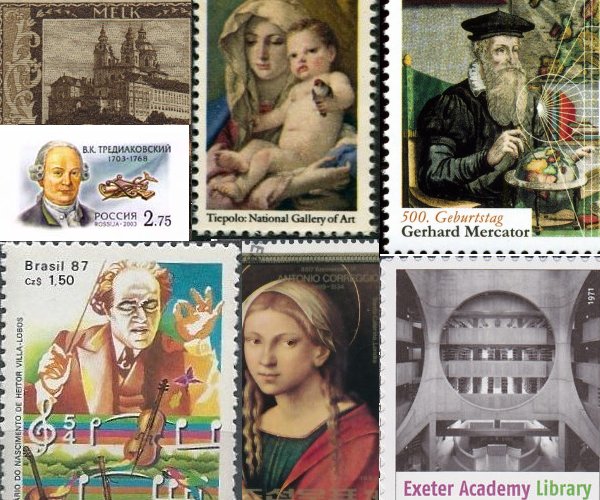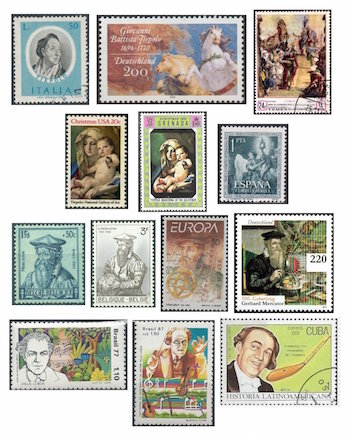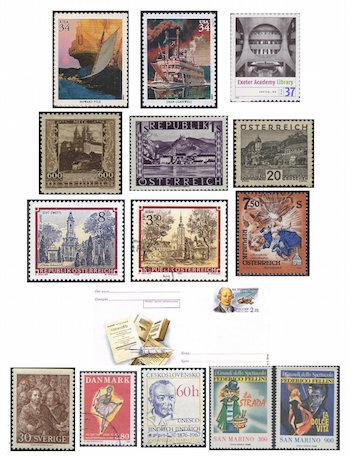The Arts on the Stamps of the World — March 5
An Arts Fuse regular feature: the arts on stamps of the world.

By Doug Briscoe
Today our featured artists include the great painters Correggio and Tiepolo, the immortal cartographer Gerardus Mercator, Brazilian composer Heitor Villa-Lobos, American illustrators Howard Pyle and Dean Cornwell, American architect Louis Kahn, and a half dozen more.
Normally I begin with birthdays, but today I think it appropriate to give pride of place to Correggio, who died on this date in 1534. Born Antonio Allegri (August 1489 – March 5, 1534) in the small town of Correggio in the north of Italy, he likely got his first training in art from his merchant father’s brother Lorenzo. From age 14 to 16 he was apprenticed in Modena. His first important commission came from Parma, where he spent most of the last two decades of his life. Most of his work is on religious topics, but there is also a set on the amorous conquests of Jupiter, commissioned by Federico II Gonzaga and based on stories from Ovid’s Metamorphoses. Correggio’s paintings have been voluminously represented on postage, and 1984, the 450th anniversary of Correggio’s death, saw a profusion of such issues. One of these, his Saint Catherine, appears on both a stamp from Antigua and one from—wait for it—North Korea! Other surprise postal origins are Cambodia (detail from Martyrdom of Four Saints) and Laos (Saints Peter, Martha, Mary Magdalene, and Leonard). The second row is devoted to a group of four anniversary issues from Dominica. On either side of a souvenir sheet of Danaë from Manama in Ajman (not to be confused with the eponymous capital of Bahrain) I’ve placed Adoration of the Child from Wallis and Futuna and one from a set of four Togolese stamps of Correggio’s numerous Madonnas. Finally, at bottom left and right, we have a Russian stamp of Portrait of a Woman (which hangs in the Hermitage) and a detail from Portrait of a Man from a Maldivian sheet.

The next collage begins with Giovanni Battista Tiepolo (March 5, 1696 – March 27, 1770), another great Italian painter, but one two centuries closer to our day. He came from Venice. His father, a shipping merchant, died just a year after Giovanni was born. At the age of 14 he was apprenticed to Gregorio Lazzarini and just a few years later was painting for the Doge. He executed his first fresco in 1716 for a church near Treviso. Much later in life Tiepolo was employed by the Prince Bishop of Würzburg and King Charles III of Spain. Next to the Italian portrait stamp, a small detail from his frescoes at the Würzburg Residenz can be seen on a German stamp issued for the bicentennial of Tiepolo’s birth. This ceiling (1754) adorns the grand entrance of the building by Balthasar Neumann; we saw that splendid entrance on a different German stamp on Neumann’s birthday back in January. (A more expansive image of the fresco is on view here.) The Yemeni stamp shows The Meeting of Anthony and Cleopatra (1747). As is so often the case, Old Master religious paintings are often employed on Christmas stamps, and so it is with the one from the United States for the 1982 season. The same Madonna of the Goldfinch had been chosen for one of the stamps issued by Grenada for Christmas 1970. The Spanish stamp reproduces Tiepolo’s Angel Bearer of the Eucharist.
We include Gerardus Mercator (1512 – 2 December 1594) for the artistry of his maps and globes, especially the 1569 world map based on the new projection he devised, still commonly in use today.
Probably the best known Brazilian composer to date is Heitor Villa-Lobos (1887 – November 17, 1959). We just recently mentioned him here in connection with his 12 guitar Etudes written for Segovia, whose birthday fell on February 21. Villa-Lobos not only wrote much more than that, he was one of the more prolific composers of the 20th century, having penned some 2000 works. From an early age, Villa-Lobos immersed himself in the musical heritage of his native Brazil. This in part grew out of a strong sense of patriotism, but Villa-Lobos was by no means averse to foreign influences, one of the most striking examples of this being his series of nine Bachianas Brasileiras, which meld native folk and popular elements with the harmonic and contrapuntal style of Bach.
It’s an unusual coincidence that two very prominent American illustrators should happen to share the same birthday. Howard Pyle (1853 – November 9, 1911) was also an author who wrote The Merry Adventures of Robin Hood (1883) and other books for young people. These volumes would typically contain his own illustrations, which he also provided for periodicals and for books by others. Born in Wilmington, Delaware (where today the Delaware Art Museum boasts a large collection of his work), he submitted an article, again with illustrations, to Scribner’s and on that sole basis was invited to pursue a professional career as an illustrator in New York City. Pyle took up the challenge but had rather a hard go of it despite encouragement from Frederick S. Church and others. After Harper’s Weekly accepted a piece in 1878, his fortunes changed for the better. Just two years later he was an established artist who came to be admired by such figures as William Morris and Vincent van Gogh (yes, really!) who said of Pyle’s work that it “… struck me dumb with admiration.” He founded the Howard Pyle School of Illustration around 1900. Pyle made a specialty of pirates, and the stamp shows his archetypal Attack on a Galleon (1905, for Harper’s Monthly).

Our other American illustrator was Dean Cornwell (1892 – December 4, 1960), who (perhaps inevitably) came to be known as the “Dean of Illustrators”. His father made mechanical drawings as a civil engineer, and the little boy was fascinated by them. He first worked as a cartoonist for the Herald newspaper in his native in Louisville, Kentucky, then went on to the Chicago Tribune (in that city he also furthered his studies at the Art Institute) and to New York City. Besides innumerable illustrations for magazines like Cosmopolitan and Good Housekeeping and for books by Pearl Buck, Hemingway, Edna Ferber, Somerset Maugham, and others, he made posters for the war effort and painted murals for buildings around the country and beyond. One such, a massive 160-foot oval, can be seen at New England Telephone’s headquarters here in Boston. It’s called Telephone Men and Women at Work, and two sections of it can be seen here and here. Cornwell was president of the Society of Illustrators (1922-26) and of the National Society of Mural Painters (1953-57). The Pyle and Cornwell stamps—the Cornwell is a piece for a True Magazine cover —both derive from a 2001 sheet of twenty stamps to which we’ll be returning repeatedly in these columns.
American architect Louis Kahn was born Itze-Leib Schmuilowsky (or Schmalowski) in what today is Estonia on 5 March (O.S. 20 February) 1901. His face was badly burned when he was only three years old, and he bore the scars all his days. Two years after this incident the family emigrated to the U.S., where his father changed their name to Kahn in 1915, one year after Louis had adopted citizenship. In his youth he played piano in silent movie theaters. A student—and later professor—at the University of Pennsylvania, Kahn co-founded the Architectural Research Group with Dominique Berninger in 1932. One of Kahn’s signature works, as indicated on the stamp, is the library at Phillips Exeter Academy, created in 1945. Louis Kahn died of a heart attack in Penn Station on March 17, 1974. I just recently had the chance to see a fascinating documentary made back in 2003 by his son Nathaniel Kahn. My Architect: A Son’s Journey was nominated for an Oscar.
A much earlier architect was the Austrian Josef Munggenast (1680 – 3 May 1741), the nephew of Jakob Prandtauer, after whose death in 1726 Munggenast undertook to complete the projects his uncle had left unfinished. These included the magnificent Melk Abbey. Munggenast further collaborated with Matthias Steinl (c1644–18 April 1727) on the towers of Zwettl Abbey and Dürnstein Abbey and renovated Altenburg and Geras Abbeys in the 1730s. All five of these are represented, sometimes more than once, on Austrian stamps. Let’s look at them, shall we? I’ve been to Melk, and its situation and aspect are impressive indeed. Its image on a 1923 stamp can only suggest its splendor. You can catch a glimpse of the Dürnstein Abbey spire on two old Austrian issues that came out just after World War II. Here’s a nice photo of the lovely sky-blue structure. Zwettl and Geras can be seen on two stamps from a handsome monastery series printed between 1984 and 1992. The Altenburg Abbey stamp primarily displays art work from inside the building but at least adds a small façade at bottom right. OK, back on the bus, please.

One of the forerunners of Russian literature was Vasily Kirillovich Trediakovsky ([O.S. 22 February] 1703 – 17 August [O.S. 6 August] 1769). This poet, essayist, and playwright was born the son of a poor priest in Astrakhan, and my researches were inadequate to determine how he managed to wind up at the Sorbonne. One source mentions something about his having been “financed by the Russian state.” Anyway, he was the first Russian commoner to be afforded such an opportunity, and he made the most of it. With studies in philosophy, linguistics, and mathematics under his belt, he was appointed acting secretary of the Academy of Sciences when he got back to Russia and was effectively also court poet. Trediakovsky wrote a treatise on poetry in 1735, introducing to the country such concepts as the sonnet and the ode, as well as the first study of Russian phonetics (A Conversation on Orthography, 1748). Beyond that, he was a prolific translator, bringing much classical, medieval, and French literature to Russian readers. Alas, because some of these translations were seen by the censors as unsuitable for the public, he lost his Academy post in 1759. There is it seems no stamp for this remarkable man, but he does have a postal card, for which I could find only a small image online.
Back to painting for Carl Gustaf Pilo (1711 – 2 March 1793), a Swedish artist who worked for thirty years at the Danish Court and as director of the Royal Danish Academy. There is much that remains obscure about Pilo’s early life, with experts disagreeing over who his teachers were and whether he ever left Scandinavia (some say he was in Vienna). He was thirty when he went to Denmark and 36 when he landed the job of court painter to the new King Frederik V. Many years later, as the result of some dust-up with one of the king’s sons, he resigned in 1775 and returned to Sweden, eventually to his hometown of Nyköping. But Swedish King Gustav III wanted to make use of his talents and insisted (Pilo apparently tried to get out of it) that he retrospectively make a painting of his coronation, which had taken place in 1771 without Pilo’s presence. This turns out to have been Pilo’s most celebrated work.
Vincenzo Galeotti (1733 – 16 December 1816) was an Italian dancer and choreographer who toured with various European ballet companies, settling for a time in Venice before being invited in 1775 to Copenhagen, where he remained for the rest of his life. (One imagines he must have shown up just as Pilo was leaving.) He essentially founded the Royal Danish Ballet. The Danish stamp was issued in 1986 for 200th anniversary of the one-act ballet Cupid and the Ballet Master, with music by Jens Lolle (1751-1789) and choreography by Galeotti.
Czech composer Jindřich Jindřich (1876 – 23 October 1967) was the son of a teacher and village cantor who studied with Vítězslav Novák. As a pianist, he accompanied Emmy Destinn and others. As a composer, he wrote mostly vocal music, notably some 170 songs and 53 choral pieces. As an ethnographer he collected 1700 folk tunes and 4000 texts and compiled a 26-volume (!) work on the language, customs, and history of the Chodové people (Chod being a dialect of Czech). His other works include an Elegy for Strings (1906) and the symphonic poem “Dawn in the Mountains” (1911).
Ennio Flaiano (1910 – 20 November 1972) gets an honorable mention as co-writer of ten screenplays with Fellini, including La Strada (1954) and La Dolce Vita (1960), for which I found these San Marino stamps. A Flaiano Prize for achievement in cinema, theater, creative writing, and literary criticism has been given annually since 1975.
I regret the absence of stamps for the author of McTeague, Frank Norris (March 5, 1870 – October 25, 1902), for English actors Henry Daniell (1894 – 31 October 1963) and Rex Harrison (1908 – 2 June 1990), and, most surprisingly to me, for Dutch townscape painter Jan van der Heyden (1637 – 28 March 1712). (Curiously enough, one of the people who made globes for Mercator was named Gaspar van der Heyden [1496 – after 1549]—no relation, I guess.)
A graduate of the University of Massachusetts with a B.A. in English, Doug Briscoe worked in Boston classical music radio, at WCRB, WGBH, and WBUR, for about 25 years, beginning in 1977. He has the curious distinction of having succeeded Robert J. Lurtsema twice, first as host of WGBH’s weekday morning classical music program in 1993, then as host of the weekend program when Robert J.’s health failed in 2000. Doug also wrote liner notes for several of the late Gunther Schuller’s GM Recordings releases as well as program notes for the Boston Classical Orchestra. For the past few years he’s been posting a Facebook “blog” of classical music on stamps of the world, which has now been expanded to encompass all the arts for The Arts Fuse.
